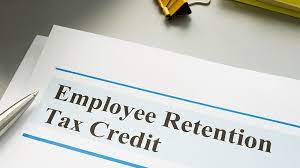
Are you a business owner wondering if you qualify for the Employee Retention Credit (ERC)?
As an experienced tax professional, I understand how important it is to stay informed about potential tax credits that can benefit your business. The ERC is a valuable credit that can provide significant relief during these challenging times.
In this article, I will guide you through the process of determining whether your business qualifies for this credit and how to claim it. We will discuss the types of businesses that can qualify, the wages that are eligible, and what records you need to file your claim.
Additionally, I will debunk common misconceptions surrounding the ERC and provide you with the deadline to claim this credit. By following this comprehensive guide, you can ensure that your business takes full advantage of the Employee Retention Credit.
Employee Retention Credit Overview
If you’re wondering if you qualify for the Employee Retention Credit, let me give you an overview of what it entails.
The Employee Retention Credit (ERC), also known as the Employee Retention Tax Credit or ERTC, is a refundable tax credit available to businesses and tax-exempt organizations. It is important to note that this credit isn’t available to individuals.
The ERC was introduced as part of the COVID-19 relief measures and aims to provide financial assistance to employers who have been significantly impacted by the pandemic. The requirements for eligibility vary depending on the time period for which you claim the credit.
To qualify for the ERC, a business must meet certain criteria. This includes experiencing either a full or partial suspension of operations due to governmental orders related to COVID-19 or having a significant decline in gross receipts compared to pre-pandemic levels. Additionally, there are employee count thresholds that need to be met.
It’s worth noting that claiming the ERC can have substantial benefits for eligible employers. It provides a dollar-for-dollar reduction in payroll taxes and is even refundable in some cases, meaning that excess credits can be received as cash refunds.
If your business has been adversely affected by COVID-19, it’s crucial to determine if you meet the requirements for the Employee Retention Credit. Consulting with a knowledgeable tax professional can help ensure that you take advantage of this valuable opportunity.
What types of business can qualify for ERC and How?
To determine whether your business is eligible for the ERC, consider the industry you operate in and evaluate if it has been affected by government orders, capacity limitations, revenue loss, or disruptions in your supply chain.
If you’re in the foodservice industry, such as restaurants, breweries, cafes, or foodservice companies, you may qualify for ERC based on factors like a significant decline in gross receipts, complete or partial shutdowns, restrictions on customer capacity, alcohol sales limitations, or issues with your vendor supplier chain.
Similarly, hotels, bed and breakfasts, motels, and other lodging establishments can qualify for ERC due to shutdowns or reduced guest capacity. If you have faced restrictions on alcohol sales and hours of operation or experienced challenges with your vendor suppliers resulting in revenue loss, you may also be eligible.
Franchise businesses like restaurants can also meet the eligibility criteria if they have experienced similar challenges as hotels and foodservice companies.
Nonprofit organizations that have seen a reduced capacity to serve clients due to government-ordered shutdowns or restricted hours may also qualify for significant funds through ERC. Remote work arrangements and issues with vendor suppliers could further support eligibility.
Recreation facilities, including gyms and fitness centers, may be eligible if they have faced restrictions on business hours or capacity limitations leading to revenue loss.
Preschools and daycare centers that have encountered shutdowns or restrictions on class sizes resulting in lower revenues and staffing challenges could potentially qualify for the credit.
Transportation companies are leading qualifiers for ERC due to various factors such as shutdowns, reduced customer capacity, loss of revenue from event cancellations, as well as customer hesitancy to use transportation services.
What types of Wages Qualify?
Qualified wages for the Employee Retention Credit include those paid to employees while businesses were partially or fully suspended due to COVID-19 government orders, as well as wages paid during a decline in gross receipts. These qualified wages are an essential aspect of determining eligibility for the credit.
When it comes to the types of wages that qualify, there are a few key considerations. First and foremost, qualified wages must be paid to employees who provide services to the business. This includes both full-time and part-time employees, as well as certain seasonal workers.
Additionally, it’s important to note that there are limits on the amount of qualified wages that can be taken into account for each employee. For businesses with more than 100 full-time employees, only wages paid to employees who were not providing services due to a government order or experiencing a decline in gross receipts can be considered. However, for businesses with 100 or fewer full-time employees, all wages paid during the eligible periods can be taken into account.
If your business experienced either partial or full suspension due to governmental COVID-19 orders or had a decline in gross receipts, you may qualify for the Employee Retention Credit. Be sure to carefully review the specific criteria and guidelines provided by the IRS to determine your eligibility and ensure you properly calculate and claim this valuable credit.
What is the maximum credit allowed?
The maximum credit allowed for the Employee Retention Credit is $7,000 per employee, per quarter or $14,000 in total. This means that if you qualify for the credit and have multiple employees, you can potentially receive up to $7,000 for each of them per quarter.
Here are some key points to consider regarding the maximum credit allowed:
- The credit is based on qualified wages paid to eligible employees.
- The credit is capped at $10,000 in qualified wages per quarter for each employee.
- The maximum credit amount is calculated by multiplying the qualifying wages by 70%.
- If your qualified wages exceed $10,000 per employee in a quarter, you will only be able to claim the maximum credit amount of $7,000.
It’s important to note that the maximum credit allowed may vary depending on your specific situation and eligibility criteria. To determine if you qualify for this credit and what amount you may be eligible for, it’s recommended that you consult with a knowledgeable tax professional or refer to official IRS guidance. They can help assess your unique circumstances and guide you through the process of claiming the Employee Retention Credit accurately.
What tax records are required to file?
Gather all your necessary tax records, like pay stubs and expense receipts, to ensure a smooth filing process. When determining if you qualify for the Employee Retention Credit (ERC), having accurate and up-to-date tax records is crucial. These records will help support your eligibility for the credit and provide evidence of qualifying wages paid during the designated time periods.
To begin with, make sure you have copies of all employee wage statements or pay stubs that show wages paid to each employee for the relevant quarters. You will also need documentation to substantiate any health plan expenses that are included in qualified wages. This may include insurance premium invoices, payment receipts, or other supporting documents.
Additionally, keep track of any eligible expenses related to maintaining a business in operation during periods affected by COVID-19. This could include rent or mortgage payment receipts, utility bills, or invoices for software and technology services used to facilitate remote work.
It’s important to note that while specific requirements may vary depending on your situation, maintaining comprehensive and organized tax records is essential when claiming the ERC. By having all these necessary documents readily available, you can confidently file for this valuable credit and maximize its benefits for your business.
What are some of the most common misconceptions regarding Employee Retention Credit?
To make the most of the Employee Retention Credit, don’t fall for these common misconceptions – understand why it’s important to educate yourself and claim the credit before the deadline.
The first misconception is that a drop in gross receipts of 20 percent or more is all that’s needed to qualify for the ERC. In reality, there are other eligibility requirements such as experiencing a full or partial suspension of business operations due to government orders.
Clients also mistakenly believe that only fully shut down businesses qualify for the ERC. However, even if there was a partial suspension or an impact/change in their business due to COVID-19, they may still be eligible.
Furthermore, some think that if their company has grown during the pandemic, they don’t qualify for the ERC. This is incorrect; businesses can still benefit from this credit regardless of growth.
What is the deadline to claim the Credit?
While the original deadline to claim the Employee Retention Credit was December 31, 2021, The credit can still be claimed using IRS Form 941-X, “Adjusted Employer’s quarterly Federal Tax Return or Claim for Refund.” A separate 941-X will need to be filed for each calendar quarter for which ERC is being claimed.
Amendments to federal tax returns generally need to be filed within three years of the original due dates, however, 941-X amendments are a little different. Generally, you may correct overreported taxes on a previously filed Form 941 if you file Form 941-X within 3 years of the date Form 941 was filed or 2 years from the date you paid the tax reported on Form 941, whichever is later. You may correct underreported taxes on a previously filed Form 941 if you file Form 941-X within 3 years of the date the Form 941 was filed.
Basically, there are only two remaining deadlines to consider: For all quarters in 2020, the deadline to apply for the ERC is April 15, 2024, and for all quarters in 2021, the deadline is April 15, 2025.
ERTC Summary
Don’t miss out on the valuable cash infusion that could help your business survive during these challenging times – make sure you understand and claim the ERC before the looming deadlines above!
The Employee Retention Credit (ERC) is a refundable tax credit designed to provide financial relief to businesses and tax-exempt organizations. It is important to understand if you qualify for this credit in order to take advantage of its benefits.
To determine if you qualify for the ERC, there are certain requirements that need to be met. The eligibility criteria differ based on the time period for which you are claiming the credit. For example, if you are claiming it for wages paid between March 13, 2020, and December 31, 2020, your business must have experienced either a full or partial suspension of operations due to government orders or a significant decline in gross receipts compared to the same quarter in prior years.
It is crucial to note that individuals are not eligible for this credit; it is exclusively available to businesses and tax-exempt organizations. By understanding these requirements and ensuring they apply to your situation, you can confidently claim the ERC and receive the financial assistance your organization may desperately need.
Remember, time is running out! Act now and take advantage of this opportunity before it’s too late. Consult with a knowledgeable professional or visit IRS.gov for more detailed information on how you can qualify for and claim the Employee Retention Credit.
Frequently Asked Questions
How long does it take to receive the Employee Retention Credit once it is claimed?
Once you claim the Employee Retention Credit, it typically takes about a few weeks to a few months to receive the credit.
The exact time frame can vary depending on various factors such as the volume of claims being processed and any potential errors or issues with your application.
It’s important to ensure that you have provided all the necessary information accurately and promptly to avoid any delays in receiving the credit.
Can a business claim the Employee Retention Credit if they received a Paycheck Protection Program (PPP) loan?
Yes, a business can claim the Employee Retention Credit even if they’ve received a Paycheck Protection Program (PPP) loan. However, it’s important to note that the credit cannot be claimed for wages that have already been forgiven under the PPP loan. The credit applies to qualified wages paid after March 12, 2020, and before January 1, 2021. To determine eligibility for the credit and calculate the amount that can be claimed, consult IRS guidance or seek professional advice.
Are there any restrictions on how the Employee Retention Credit can be used by the business?
There are some restrictions on how the Employee Retention Credit can be used by your business. The credit can only be used to offset certain employment taxes, including the employer portion of Social Security taxes.
Additionally, any amount of the credit that exceeds your payroll tax liability cannot be refunded or carried forward.
It’s important to carefully review the IRS guidelines and consult with a tax professional to ensure you’re using the credit properly.
Is the Employee Retention Credit available for self-employed individuals or independent contractors?
Yes, the Employee Retention Credit is available for self-employed individuals and independent contractors.
To determine if you qualify, you must meet certain criteria such as experiencing a significant decline in gross receipts or having your business partially or fully suspended due to government orders.
You may be able to claim the COVID credit for the self-employed if you were unable to work due to COVID and you meet the IRS’s requirement criteria. Review these specific guidelines to ensure that you meet all eligibility requirements:
1. You Were Self-Employed
2. You Would Be Eligible for Sick or Family Leave Pay if You Were Employed
3. You Have Records to Support Your Claims
It’s recommended to consult with a tax professional for personalized guidance on your situation.
Can a business claim the Employee Retention Credit for employees who were furloughed or laid off but later rehired?
Yes, a business can claim the employee retention credit for employees who were furloughed or laid off but later rehired. The IRS has provided guidance stating that if an employer rehires and pays wages to an employee after they were previously laid off or furloughed due to COVID-19, those wages are eligible for the employee retention credit.
It’s important to keep proper documentation and meet all other eligibility requirements outlined by the IRS to claim this credit.
Conclusion
In conclusion, determining if you qualify for the Employee Retention Credit (ERC) is crucial for maximizing your tax benefits. By understanding the eligibility criteria and keeping track of qualifying wages, you can take advantage of this valuable credit.
Make sure to maintain accurate tax records to support your claim and avoid common misconceptions surrounding the ERC.
Lastly, be mindful of the deadline to claim the credit and take timely action to secure your benefits. With careful consideration and expert guidance, you can make the most of the ERC and optimize your business’s financial position.





